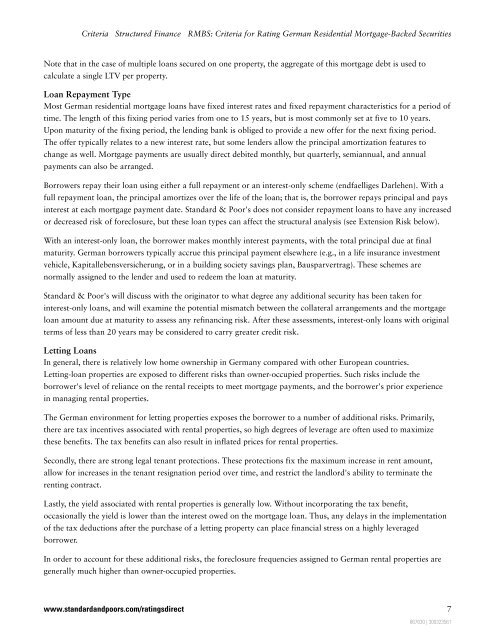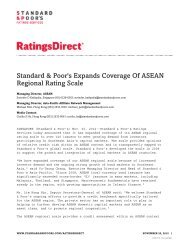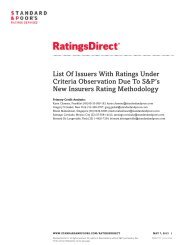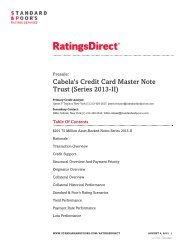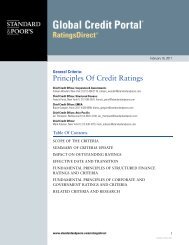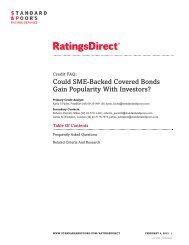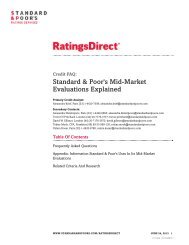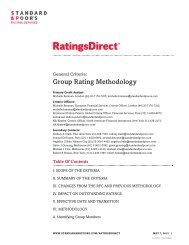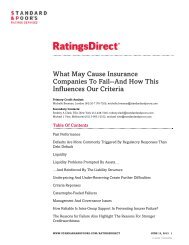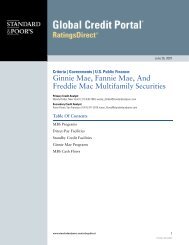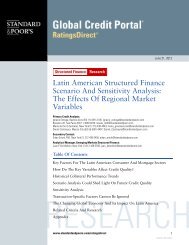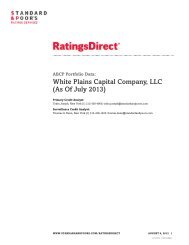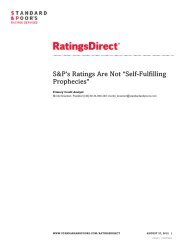Criteria for Rating German Residential Mortgage ... - Standard & Poor's
Criteria for Rating German Residential Mortgage ... - Standard & Poor's
Criteria for Rating German Residential Mortgage ... - Standard & Poor's
Create successful ePaper yourself
Turn your PDF publications into a flip-book with our unique Google optimized e-Paper software.
Note that in the case of multiple loans secured on one property, the aggregate of this mortgage debt is used to<br />
calculate a single LTV per property.<br />
Loan Repayment Type<br />
Most <strong>German</strong> residential mortgage loans have fixed interest rates and fixed repayment characteristics <strong>for</strong> a period of<br />
time. The length of this fixing period varies from one to 15 years, but is most commonly set at five to 10 years.<br />
Upon maturity of the fixing period, the lending bank is obliged to provide a new offer <strong>for</strong> the next fixing period.<br />
The offer typically relates to a new interest rate, but some lenders allow the principal amortization features to<br />
change as well. <strong>Mortgage</strong> payments are usually direct debited monthly, but quarterly, semiannual, and annual<br />
payments can also be arranged.<br />
Borrowers repay their loan using either a full repayment or an interest-only scheme (endfaelliges Darlehen). With a<br />
full repayment loan, the principal amortizes over the life of the loan; that is, the borrower repays principal and pays<br />
interest at each mortgage payment date. <strong>Standard</strong> & <strong>Poor's</strong> does not consider repayment loans to have any increased<br />
or decreased risk of <strong>for</strong>eclosure, but these loan types can affect the structural analysis (see Extension Risk below).<br />
With an interest-only loan, the borrower makes monthly interest payments, with the total principal due at final<br />
maturity. <strong>German</strong> borrowers typically accrue this principal payment elsewhere (e.g., in a life insurance investment<br />
vehicle, Kapitallebensversicherung, or in a building society savings plan, Bausparvertrag). These schemes are<br />
normally assigned to the lender and used to redeem the loan at maturity.<br />
<strong>Standard</strong> & <strong>Poor's</strong> will discuss with the originator to what degree any additional security has been taken <strong>for</strong><br />
interest-only loans, and will examine the potential mismatch between the collateral arrangements and the mortgage<br />
loan amount due at maturity to assess any refinancing risk. After these assessments, interest-only loans with original<br />
terms of less than 20 years may be considered to carry greater credit risk.<br />
Letting Loans<br />
In general, there is relatively low home ownership in <strong>German</strong>y compared with other European countries.<br />
Letting-loan properties are exposed to different risks than owner-occupied properties. Such risks include the<br />
borrower's level of reliance on the rental receipts to meet mortgage payments, and the borrower's prior experience<br />
in managing rental properties.<br />
The <strong>German</strong> environment <strong>for</strong> letting properties exposes the borrower to a number of additional risks. Primarily,<br />
there are tax incentives associated with rental properties, so high degrees of leverage are often used to maximize<br />
these benefits. The tax benefits can also result in inflated prices <strong>for</strong> rental properties.<br />
Secondly, there are strong legal tenant protections. These protections fix the maximum increase in rent amount,<br />
allow <strong>for</strong> increases in the tenant resignation period over time, and restrict the landlord's ability to terminate the<br />
renting contract.<br />
Lastly, the yield associated with rental properties is generally low. Without incorporating the tax benefit,<br />
occasionally the yield is lower than the interest owed on the mortgage loan. Thus, any delays in the implementation<br />
of the tax deductions after the purchase of a letting property can place financial stress on a highly leveraged<br />
borrower.<br />
<strong>Criteria</strong> Structured Finance RMBS: <strong>Criteria</strong> <strong>for</strong> <strong>Rating</strong> <strong>German</strong> <strong>Residential</strong> <strong>Mortgage</strong>-Backed Securities<br />
In order to account <strong>for</strong> these additional risks, the <strong>for</strong>eclosure frequencies assigned to <strong>German</strong> rental properties are<br />
generally much higher than owner-occupied properties.<br />
www.standardandpoors.com/ratingsdirect 7<br />
867630 | 300323561


